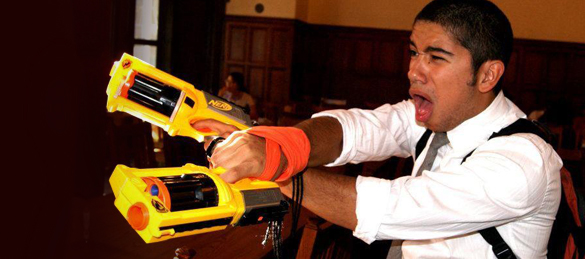| Sun | Mon | Tue | Wed | Thu | Fri | Sat |
|---|---|---|---|---|---|---|
| 1 | 2 | 3 | 4 | 5 | ||
| 6 | 7 | 8 | 9 | 10 | 11 | 12 |
| 13 | 14 | 15 | 16 | 17 | 18 | 19 |
| 20 | 21 | 22 | 23 | 24 | 25 | 26 |
| 27 | 28 | 29 | 30 | 31 |
CATEGORIES
RECENT ENTRIES
BLOG ROLL
Wanted: Undead or alive

When a zombie infection spread across campus, a student task force armed the resistance.
By Mitchell Kohles, ’12
Now that it’s all over, it’s safe to talk about it. Humans vs. Zombies (HvZ), the one-week event in which a zombie infection spread across campus, ended with nearly everyone dead… er, undead.
It all started on Tuesday of second week, October 4. At 9 p.m. 190-something students gathered in the middle of the main quad to receive bright orange bandanas and foam-dart guns—the standard issue Nerf Maverick is rented out from the Zombie Readiness Task Force (ZRTF) for $5, but several “humans” opt for more heavy arms and purchase them independently.
Every player (except one, the original zombie) receives a weapon to defend themselves from the zombies who, if shot, have to run out of sight of the humans before attacking again. If you’re touched—infected—by a zombie, you lay down your weapon and join the walking dead.
It takes the ZRTF more than a month to prepare each game—just four students serve on the officer board—and the RSO usually reserves the main quad and a campus building for one or more nights during the week-long attack. These games are the only visible evidence of the ZRTF, but the group meets throughout the year to tweak the rules of each upcoming game. This year’s rule changes: Pierce is a safe zone, except for the front lobby; socks can be used as projectiles but not as melee weapons; no shields allowed, whatsoever.
At the dining hall on Friday morning, I asked one of my residents, Robin, how he’d managed to survive this long. “I don’t go outside. It’s kind of nice though because I get escorted wherever I go.” As it turns out, there is a hotline for humans to call and request an escort to anywhere on campus. “Walking alone is suicide. If you go out there alone, they [start chasing you], and you only have six bullets." Robin gestured to his two guns, connected by a piece string so that with one motion he can simultaneously load the next round in each gun. “Well, 12.” After breakfast, Robin made plans with a few fellow humans to get him safely to a 10:30 math class in Ryerson. It sounds like there will be running involved. “Hopefully I’ll see you guys tonight. As a human.”
“After the first day, about 50 percent were zombies. After the second day, 80 percent,” says Kevin Wang, Colonel of the ZRTF and a main organizer of this fall’s game. Running a campus-wide event of this scale attracts attention, and not all of it was welcome. Several non-player students donned orange bandanas of their own and patrolled the quads in search of the remaining humans, causing confusion among players and havoc among ZRTF members. Eventually, a directive was sent out to all the players to take the bandanas from the phony zombies.
The following Tuesday, the few remaining humans gathered for a final mission on the main quad. The objective: escort two scientists to three checkpoints and then get them safely to the Gordon Center for Integrative Sciences. Unfortunately, the humans were outnumbered, and those who didn't abandon the mission early on were soon cornered and converted into cold-blooded [I like "over-educated", but maybe that doesn't fly] brain-eaters [again, I like cerebrophages, but maybe too much?].
Chris Dewing was chosen to be the original zombie, both an honor and a responsibility. "It is a burden in the sense you don't want to be a failure," said Dewing over email. "One needs to by sure to get kills quickly, efficiently, and frequently." Plus, there's all that guilt.
Scorned and bitter zombies don’t have to wait long to try their hand at being human again. The next game is planned for eighth week of winter quarter. How will the snow affect the infection? “I’m excited," says Wang. "I think it just adds another element to the gameplay."
So, is there any cure? “There would have been one if they had completed the mission,” says Wang, “but no one did.”
October 26, 2011
